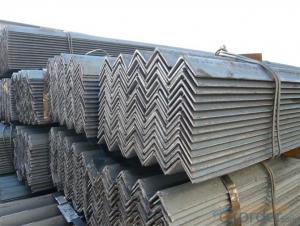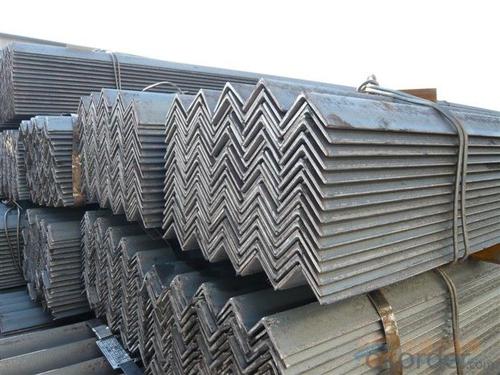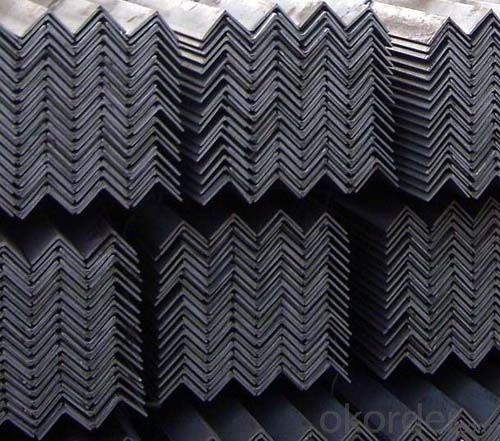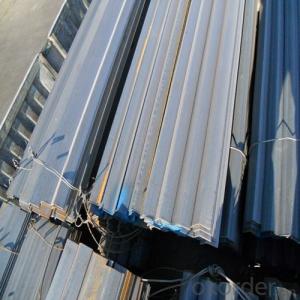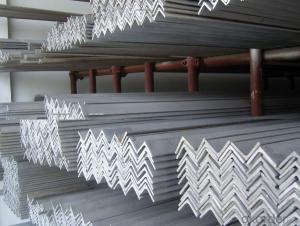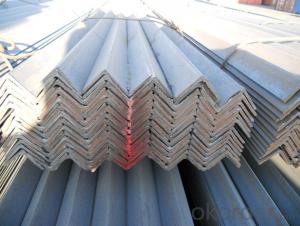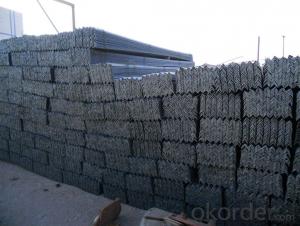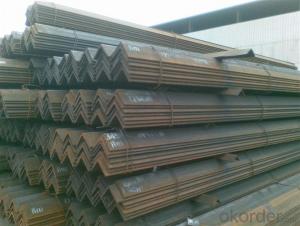GB Q345 Steel Angle with High Quality 90*90mm
- Loading Port:
- Tianjin
- Payment Terms:
- TT or LC
- Min Order Qty:
- 25 m.t
- Supply Capability:
- 10000 m.t/month
OKorder Service Pledge
OKorder Financial Service
You Might Also Like
Specifications of GB Q345 Steel Angle with High Quality 90*90mm:
1.Standards: GB
2.Material: Q345 or Equivalent
3.Length: 6m, 12m
4.Size:
| Size (mm) | Mass (kg/m) | Size (mm) | Mass (kg/m) |
| 90*90*7 | 9.656 | 90*90*10 | 13.478 |
| 90*90*8 | 10.946 |
Usage & Applications of GB Q345 Steel Angle with High Quality 90*90mm:
Trusses;
Transmission towers;
Telecommunication towers;
Bracing for general structures;
Stiffeners in structural use.
Packaging & Delivery of GB Q345 Steel Angle with High Quality 90*90mm:
1. Transportation: the goods are delivered by truck from mill to loading port, the maximum quantity can be loaded is around 40MTs by each truck. If the order quantity cannot reach the full truck loaded, the transportation cost per ton will be little higher than full load.
2. With bundles and load in 20 feet/40 feet container, or by bulk cargo, also we could do as customers' request.
3. Marks:
Color mark: There will be color marking on both end of the bundle for the cargo delivered by bulk vessel. That makes it easily to distinguish at the destination port.
Tag mark: There will be tag mark tied up on the bundles. The information usually including supplier logo and name, product name, made in China, shipping marks and other information request by the customer.
If loading by container the marking is not needed, but we will prepare it as customers' request.
FAQ:
Q1: Why buy Materials & Equipment from OKorder.com?
A1: All products offered byOKorder.com are carefully selected from China's most reliable manufacturing enterprises. Through its ISO certifications, OKorder.com adheres to the highest standards and a commitment to supply chain safety and customer satisfaction.
Q2: How do we guarantee the quality of our products?
A2: We have established an advanced quality management system which conducts strict quality tests at every step, from raw materials to the final product. At the same time, we provide extensive follow-up service assurances as required.
Q3: How soon can we receive the product after purchase?
A3: Within three days of placing an order, we will arrange production. The shipping date is dependent upon the quatity, how many sizes you want and the plan of production, but is typically 30 to 45 days from the beginning of production.
Images of GB Q345 Steel Angle with High Quality 90*90mm:

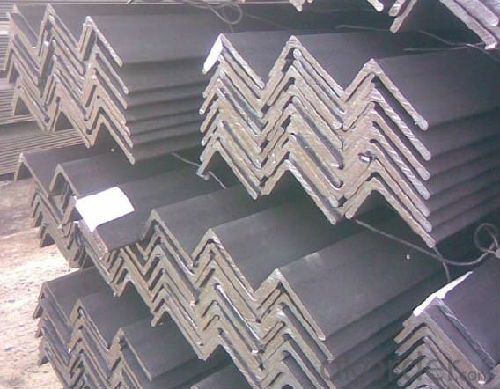
*If you would like to get our price, please inform us the size, standard/material and quantity. Thank you very much for your attention.
- Q: How do you transport steel angles safely?
- Proper planning and adherence to specific guidelines are necessary for the safe transportation of steel angles. To ensure their safe transport, the following steps should be taken: 1. Secure the steel angles: Before transportation, it is important to securely fasten the steel angles. This can be achieved by using straps or chains to hold them firmly in place. Avoid any movement or shifting of the angles during transit by ensuring they are tightly secured. 2. Choose appropriate transportation equipment: Depending on the quantity and size of the steel angles, select suitable transportation equipment. Flatbed trucks or trailers with secure tie-down points are commonly used for this purpose. If needed, specialized equipment such as cranes or forklifts can be utilized for safe loading and unloading. 3. Safeguard the steel angles: To prevent damage during transit, it is crucial to protect the steel angles from potential hazards. This can be done by using adequate packaging materials like cardboard or wooden crates to cover and provide additional support. Additionally, consider using protective padding or blankets to prevent scratches or dents. 4. Ensure proper weight distribution: Maintaining proper weight distribution is essential for stability during transportation. Distribute the load evenly across the transportation equipment to avoid imbalance or tipping. If necessary, consult weight distribution guidelines or seek professional advice to ensure safe transportation. 5. Adhere to local regulations: Familiarize yourself with the transportation regulations and guidelines in your area. Ensure compliance with any specific requirements regarding load securing, maximum weight limits, or permits for oversized shipments. This will guarantee legal compliance and safe transportation. 6. Inspect and maintain the transportation equipment: Regularly inspect the transportation equipment for any signs of wear and tear. Check the condition of straps, chains, or tie-down points to ensure they are in good working condition. Proper maintenance of the equipment reduces the risk of accidents or incidents during transportation. 7. Plan the route and consider weather conditions: Before transporting the steel angles, carefully plan the route, taking into account any potential obstacles or road conditions that may affect safety. Be aware of height or weight restrictions on certain roads or bridges. Additionally, consider weather conditions such as heavy rain, snow, or strong winds, and adjust the transportation plan accordingly. By following these steps and taking necessary precautions, you can safely transport steel angles, minimizing the risk of damage, accidents, or injuries. Always prioritize safety and comply with applicable regulations for a successful transportation process.
- Q: What is the fire resistance rating of steel angles?
- The fire resistance rating of steel angles depends on various factors such as the size and thickness of the angle, the type of steel used, and the specific fire protection measures implemented. Steel is inherently fire-resistant due to its high melting point and low thermal conductivity. However, the fire resistance rating can be enhanced by applying fireproofing materials, such as intumescent coatings or fire-resistant boards, to the steel angles. These fire protection measures can significantly increase the fire resistance rating of steel angles by providing insulation and slowing down the transfer of heat to the steel. The specific fire resistance rating can vary based on the thickness and type of fireproofing materials used. For example, a steel angle with a certain fireproofing coating may have a fire resistance rating of 60 minutes, meaning it can withstand exposure to fire for up to 60 minutes before losing its structural integrity. It is important to consult local building codes, regulations, and fire safety standards to determine the specific fire resistance requirements for steel angles in a particular application. These standards can provide guidance on the necessary fire protection measures and the minimum fire resistance ratings that need to be met in different construction scenarios.
- Q: Can steel angles be used in modular or prefabricated construction?
- Yes, steel angles can be used in modular or prefabricated construction. Steel angles are commonly used as structural components in construction due to their strength and versatility. They can be easily fabricated and integrated into modular or prefabricated building systems, allowing for efficient and cost-effective construction processes. Steel angles can be used to provide structural support, reinforce connections, and create framing systems in modular or prefabricated buildings. Additionally, their ability to be customized and adapted to various design requirements makes them suitable for a wide range of building applications in the modular or prefabricated construction industry.
- Q: How do you determine the plastic section modulus of a steel angle?
- To determine the plastic section modulus of a steel angle, you need to follow a specific calculation process. The plastic section modulus (Z) is a measure of the ability of a cross-section to resist plastic bending. It is commonly used in structural engineering to analyze the strength and stability of members. To calculate the plastic section modulus of a steel angle, you need to know the dimensions of the angle cross-section, including the length of the legs and the thickness of the steel. Once you have these measurements, you can follow the steps below: 1. Identify the centroid of the angle cross-section: The centroid is the geometric center of the shape and is an important reference point for calculating the plastic section modulus. You can determine the centroid by finding the average of the coordinates of the vertices. 2. Calculate the moment of inertia (I): The moment of inertia is a measure of how the area is distributed around the centroid. It can be found by summing the individual moments of inertia for each component of the cross-section. For a steel angle, the moment of inertia can be calculated using standard formulas or tables. 3. Determine the plastic section modulus (Z): The plastic section modulus is directly related to the moment of inertia. It can be calculated by dividing the moment of inertia (I) by the distance from the centroid to the outermost fiber of the section. This distance is known as the distance to the extreme fiber (c) and is usually equal to half the thickness of the angle. The formula to calculate the plastic section modulus (Z) is Z = I / c. 4. Substitute the values: Once you have determined the moment of inertia (I) and the distance to the extreme fiber (c), plug these values into the formula to calculate the plastic section modulus (Z). By following these steps, you can determine the plastic section modulus of a steel angle. The plastic section modulus is a critical parameter in assessing the structural behavior and design of steel angles, especially when subjected to bending loads.
- Q: How are steel angles different from steel channels?
- Steel angles and steel channels are both types of structural steel shapes that are commonly used in construction and engineering projects. However, they differ in terms of their shape and structural properties. Steel angles have an L-shaped cross-section, with two legs that are perpendicular to each other. The legs of steel angles can have equal or unequal lengths, depending on the specific application. Steel angles are typically used to provide structural support in applications such as framing, bracing, and reinforcement. They are often used in construction projects to provide stability and strength to structures. On the other hand, steel channels have a U-shaped cross-section, with two parallel flanges connected by a web. The flanges are oriented in the same direction, while the web connects them. Steel channels are commonly used in applications that require load-bearing capabilities, such as building frameworks, support beams, and infrastructure projects. They are designed to distribute weight evenly and provide structural stability. In terms of their structural properties, steel angles are known for their high strength-to-weight ratio. This makes them suitable for applications where strength and durability are crucial. Steel angles can be easily welded, bolted, or riveted, making them versatile and easy to work with. Steel channels, on the other hand, offer excellent load-bearing capabilities due to their U-shaped design. The parallel flanges provide increased strength and stability, making them ideal for supporting heavy loads and resisting bending or twisting forces. Steel channels are also known for their resistance to warping and twisting, ensuring the structural integrity of the project. In summary, steel angles and steel channels differ in terms of their shape and structural properties. Steel angles have an L-shaped cross-section and are commonly used for framing and reinforcement, while steel channels have a U-shaped cross-section and are used for load-bearing applications. Understanding the differences between these two types of structural steel shapes is essential for selecting the appropriate one for a specific construction or engineering project.
- Q: Can steel angles be drilled?
- Yes, steel angles can be drilled. Steel angles are commonly used in construction and fabrication projects, and drilling holes in steel angles is a common practice. However, drilling steel angles may require specialized drilling equipment, such as a drill press or a high-speed steel drill bit, due to the hardness of the steel. Additionally, using cutting lubricants or coolants during the drilling process can help to reduce heat and extend the life of the drill bit. Overall, with the right tools and techniques, steel angles can be easily drilled to accommodate various construction and fabrication needs.
- Q: How do you calculate the second moment of area for a steel angle?
- The second moment of area for a steel angle can be calculated by multiplying the width of the angle squared, multiplied by the thickness cubed, and divided by 12.
- Q: Can steel angles be used for support structures in telecommunications installations?
- Yes, steel angles can be used for support structures in telecommunications installations. Steel angles are commonly used in construction and engineering applications due to their strength and durability. They provide excellent support and can withstand heavy loads and harsh environmental conditions. In telecommunications installations, steel angles are often used for mounting antennas, satellite dishes, and other equipment. They offer a stable and secure platform for the installation of telecommunications infrastructure, ensuring reliable and efficient communication networks. Additionally, steel angles can be easily customized and fabricated to meet specific design requirements, making them a versatile choice for support structures in telecommunications installations.
- Q: Can steel angles be used in seismic zones?
- Certainly! Steel angles are suitable for use in seismic zones. They are frequently employed in construction, even in areas prone to earthquakes, because they offer valuable structural support and resistance against sideways forces caused by seismic activity. To ensure the building's structural integrity during an earthquake, the installation and design of steel angles in seismic zones must comply with local building codes and regulations. These regulations often necessitate additional reinforcement and connections. Engineers and architects may also employ various design techniques and strategies, like moment frames or braced frames, to further enhance the seismic performance of structures utilizing steel angles. Overall, with careful attention to design, installation, and adherence to seismic design codes and regulations, steel angles can be effectively utilized in seismic zones.
- Q: How do you prevent corrosion on steel angles?
- One effective method to prevent corrosion on steel angles is by applying a protective coating such as paint or zinc. This barrier creates a physical barrier between the steel and the corrosive elements in the environment, preventing direct contact and reducing the chances of corrosion. Regular maintenance and inspection, along with promptly addressing any signs of damage or rust, can also help prevent corrosion on steel angles.
Send your message to us
GB Q345 Steel Angle with High Quality 90*90mm
- Loading Port:
- Tianjin
- Payment Terms:
- TT or LC
- Min Order Qty:
- 25 m.t
- Supply Capability:
- 10000 m.t/month
OKorder Service Pledge
OKorder Financial Service
Similar products
Hot products
Hot Searches
Related keywords
